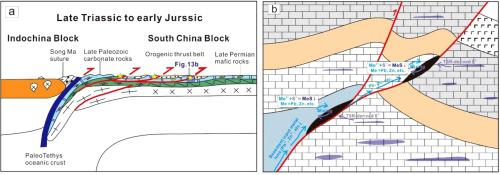Journal of Asian Earth Sciences ( IF 2.7 ) Pub Date : 2021-08-03 , DOI: 10.1016/j.jseaes.2021.104914 Chen Wei 1, 2 , Zhilong Huang 1 , Lin Ye 1 , Yusi Hu 1 , M. Santosh 3, 4 , Tao Wu 1, 2 , Lianglun He 5 , Jiawei Zhang 1, 6 , Zhiwei He 7, 8 , Zhenzhong Xiang 1, 2 , Da Chen 9 , Chuanwei Zhu 1 , Zhongguo Jin 9

|
The Sichuan-Yunan-Guizhou triangle region contains numerous economically important carbonate-hosted Zn-Pb deposits that occur in the Late Indosinian thrust and fold system rather than foreland basin. In this paper, we investigate the thrust-controlled Zhugongtang deposit (>30.0 Mt ores @ 6.76 wt% Zn and 2.27 wt% Pb) as a case study, using ore deposit geology, in-situ trace elements and isotopes in sulfides, to provide new insights into the ore genesis of the MVT deposits in the thrust belts. The sulfide orebody is structurally controlled by a kilometer-scale thrust system and occurs as open-space fillings, vein or replacement structures. Trace elements in pyrite show a low concentration of Co, Ni, Tl and Se, suggesting that the sulfides were formed under low-temperature (100–250 °C) and slightly reduced conditions. The δ13CPDB values (−7.53 to +1.73‰) in calcite lie between the marine carbonate rocks and sedimentary organic matter, and the calculated δ18Ofluid values (+3.40 to +13.36‰) are different from that of marine carbonate rocks but partly overlap with the basinal brines. Such C-O isotope signature indicates that the carbon was mainly derived from the host rocks (limestone) with additional contribution from organic carbon. The oxygen isotope values suggest mixing of the basinal brine and the limestone. The δ34S values of sulfides within Permian strata (+12.2 to +15.3‰) and Devonian strata (+18.5 to +23.8‰) are similar to the coeval seawater sulfate within the ore-hosting strata, respectively. This indicates that the reduced sulfur is originated from evaporative sulfate within host rocks by thermo-chemical reduction in the near-close system. In-situ Pb isotopic ratios of galena (206Pb/204Pb = 18.566–18.758, 207Pb/204Pb = 15.757–15.769 and 208Pb/204Pb = 39.061–39.366) are comparable with the Proterozoic basement and the country rocks, indicating the mineralizing metals were mainly derived from basement rocks and partly extracted from country rocks via fluid-rock interaction. Regional geological evidence indicates the timing of Zn-Pb mineralization of Zhugongtang is Late Triassic to Early Jurassic and related to the Indosinian orogeny. Overall, the newly obtained trace element and isotopic data together with geological evidence suggest that the Zhugongtang deposit is an MVT deposit formed in the orogenic thrust belt and that fluid mixing was critical for the ore formation.
中文翻译:

印支晚期冲断褶皱系统碳酸盐岩锌铅矿床成因——以华南新发现的巨型竹公塘矿床为例
川滇黔三角地区包含大量具有重要经济意义的碳酸盐岩锌铅矿床,这些矿床产于印支晚期冲断褶皱系统而非前陆盆地。在本文中,我们利用矿床地质、原位微量元素和硫化物同位素,以推力控制的朱公塘矿床(>30.0 Mt 矿石 @ 6.76 wt% Zn 和 2.27 wt% Pb)为案例研究,以提供对冲断带中 MVT 矿床的矿石成因的新见解。硫化矿体在构造上受千米级冲断系统控制,以空地充填物、脉状或置换构造形式出现。黄铁矿中的微量元素显示出低浓度的 Co、Ni、Tl 和 Se,表明硫化物是在低温(100-250°C)和轻微还原条件下形成的。δ 13方解石中的C PDB值(-7.53 至 +1.73‰)介于海相碳酸盐岩和沉积有机质之间,计算的 δ 18 O流体值(+3.40 至 +13.36‰)与海相碳酸盐岩不同但部分不同与盆地卤水重叠。这种 CO 同位素特征表明碳主要来自主岩(石灰岩),另外还有有机碳的贡献。氧同位素值表明盆地盐水和石灰石混合。δ 34二叠系(+12.2~+15.3‰)和泥盆系(+18.5~+23.8‰)内硫化物的S值分别与赋矿地层内的同期海水硫酸盐相似。这表明还原的硫来源于近封闭系统中通过热化学还原在主岩内蒸发的硫酸盐。原位铅方铅矿的同位素比值(206 PB / 204 PB = 18.566-18.758,207的Pb / 204 PB = 15.757-15.769和208的Pb / 204Pb = 39.061–39.366) 与元古代基底和围岩相当,说明矿化金属主要来源于基底岩,部分通过流体-岩石相互作用从围岩中提取。区域地质证据表明,竹公塘锌铅矿化的时间为晚三叠世至早侏罗世,与印支造山运动有关。总体而言,新获得的微量元素和同位素数据以及地质证据表明,竹公塘矿床是形成于造山冲断带的 MVT 矿床,流体混合对成矿至关重要。











































 京公网安备 11010802027423号
京公网安备 11010802027423号